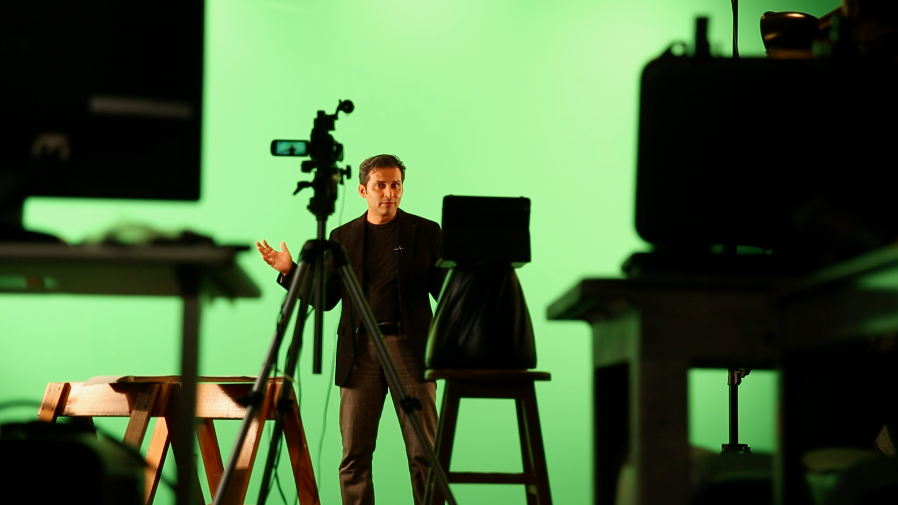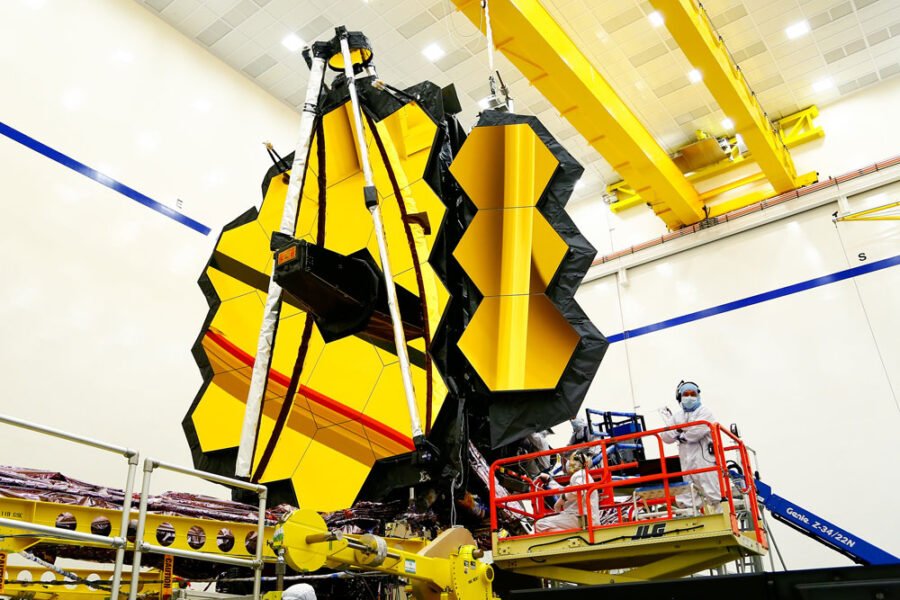The universe we know today is immense, both in size and time. It contains hundreds of billions of galaxies. And yet, there was a time when there were no stars and no galaxies. We are a curious species, so we want to know the unknown: when did the first stars light up the universe? When did some of the extensive collection of stars first assemble into galaxies? And how do stars and planets form in the first place?
There is a genuine excitement for those interested in these questions as a phenomenal new telescope, the James Webb Space Telescope (JWST), has launched into space on December 25, 2021, and has successfully reached its destination point Lagrange 2, a million miles from earth in 29 days.
Telescopes have altered the way we think about our place in the cosmos. It was only a little over 400 years ago that Galileo pointed a small telescope to the skies and found splotches on the sun, mountains on the moon, and observed that Venus goes through phases just like our moon.
But the most amazing discovery was that of four never-before-seen objects. Instead of the Earth, they orbited Jupiter. This was stunning. It helped overthrow the existing view of Earth being at the center of the universe. Today, we know that these are the four largest moons of Jupiter.
But this was just the beginning. We are now accustomed to hearing about the discoveries of asteroids, exploding stars, strange galaxies, and even the faint murmurs from colliding black holes. The most famous telescope has been the Hubble Space Telescope, launched in 1990, which revolutionised astronomy.
It took many iconic images. But I was blown away by the Hubble Deep Field. I was in graduate school at the time the image was taken. The telescope had stared at a small portion of the sky, about 100th the size of the full moon, for over 140 hours. Astronomers did not know what they would find in this seemingly blank piece of sky.
The result was astonishing! Hubble revealed this tiny patch on the sky to be full of galaxies. Every little smudge is a galaxy containing tens of billions of stars. Some of these galaxies are very young and so far away that their light started its journey when the universe was less than a billion years old.
But can we find some of the very first galaxies, perhaps only a few hundred million years after the Big Bang?
This is where the JWST comes in. It is a marvel of creativity and human ingenuity. The work on this telescope started 25 years ago. Most of the technology that went into building the telescope had to be invented and the cost soared to over 10 billion dollars.
It is a worthy successor of Hubble. The main mirror of the Hubble Telescope was about 2.4 meters in diameter. In fact, astronomers use the diameter of the primary mirror to describe the size of a telescope. The mirror of the JWST is 6.5 meters across. This means that it has five times the light gathering ability of Hubble!
One big difference is that JWST will only look in the infrared spectrum, light that is not visible to humans. But it can provide crucial information about the universe. Don’t worry, those infrared images are still going to be turned into beautiful images to be appreciated by human eyes. Hubble, on the other hand, worked primarily in visible light.
The JWST will be located about 1.5 million km from Earth, much further than the distance between the Earth and the moon. Such a distance will allow the telescope to be shielded from the infrared glow of the Earth and will keep the instruments very cold, something that is required for it to work with high sensitivity. The telescope is also equipped with a light five-layer sun-shield, the size of a tennis court, that will provide added protection from the heat from the sun.
The telescope mirror itself is a combination of 18 hexagonal mirrors. They are made up of beryllium with a fine coating of gold. Beryllium was picked as it is stiff and yet ultralight, and it can retain its shape even in the cold temperatures of outer space. Light reflects off gold with higher efficiency than most other elements. Since light is the primary currency for astronomers, a gold coating is simply worth the price.
If something goes wrong, and I am already trembling while writing the sentence, the telescope is too far for any astronaut mission to fix it. However, the engineers have provided the telescope with the ability to shake and shimmy. There is some comfort in knowing that, when all else fails, our own solution to fixing a toaster or a television set is not that different from a cutting-edge instrument exploring the universe.
The first images from the telescope are expected in six months. But what do we expect to see?
One of Hubble’s deepest images of space led astronomers to the discovery of well-formed galaxies going back only 400 million years after the Big Bang. Most theories predicted a much longer time for the formation of the first galaxies.
The detection by Hubble was a fluke. The expansion of the universe would make the light from these young galaxies shift predominantly to the infrared (this is called the Doppler effect and we have all experienced it in sound waves when the pitch of an ambulance increases on its approach to you and then decreases when it is moving away from you). The instruments on the JWST should be able to detect the population of these nascent galaxies and allow us an insight into the processes through which galaxies grow and develop. In fact, it may even find the indirect signatures of the very first stars that lit up the universe.
There is more to discover in our own galaxy as well. Stars like our sun are born in clouds of gas and dust. The beautiful Orion Nebula in the winter skies is a stellar nursery. However, the same gas and dust absorb much of the visible light and hide the details of the birth of these stars. But infrared light peers through dust. Through its infrared eyes, JWST is expected to lift the veil of dust and allow us a peek at the processes that not only form stars but also the planets around them.
Then there are the exoplanets — planets that orbit other stars. During the last 25 years, astronomers have identified more than 4,000 exoplanets! An astounding number. In fact, one of the exoplanets has officially been named by Pakistan. Called Perwana, it orbits a star now named Shama. But we don’t know if any of the exoplanets are suitable for life. The JWST will be able to identify the composition of the atmospheres of some of these planets.
It will not detect life directly, but it will be able to see if elements such as methane, water, and carbon dioxide are present in quantities that may support life as we know it. One of the first targets of the telescope will be the Trappist-1 system that hosts at least seven Earth-sized planets. Three of these are in the habitable zone, meaning that they orbit the star at a distance where water can exist in liquid form on the surface. Now the JWST will have a chance to give us the first look into these alien atmospheres.
We all have busy lives. We are also inundated with news about politics, wars, and, lately, about the devastating pandemic. But for a change, let’s take a moment to appreciate the imagination and creativity that has gone into the construction of the James Webb Space Telescope. All for the purpose of answering some of humanity’s fundamental questions about our origins.
The article originally published in EOS, Dawn, reshared with the permission of the author.
Also, Read: Gazing at the stars and beyond with Dr. Salman Hameed

The writer is Associate Professor of Integrated Science & Humanities at Hampshire College, US. He is also an astronomer affiliated with the Five College Astronomy Department (FCAD) in Massachusetts and hosts a YouTube channel, Kainaat Astronomy in Urdu.

